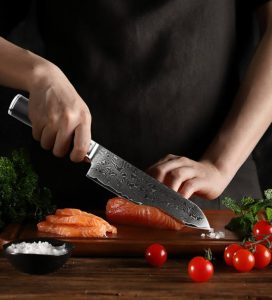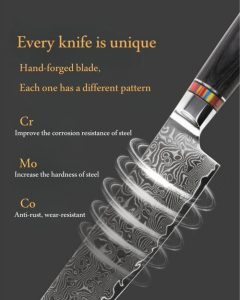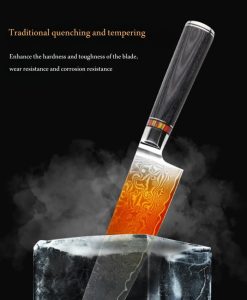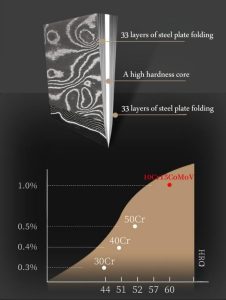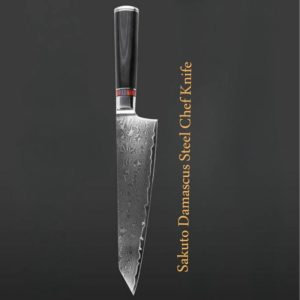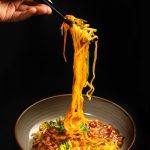The Role of Japanese Knives in Gourmet Cooking
Three key qualities set Japanese knives apart - the steel, construction, and edges. Let's look at each one.
- The Steel
Japanese knives tend to use two types of high-carbon steel alloys: VG-10 or SUS410. The additional carbon makes the steel harder, allowing it to hold a sharp edge. However, it also makes the blades more brittle overall.
To compensate, knife makers sandwich this hard steel between outer layers of softer stainless steel. This protects the inner core while also restricting excessive wear.
Some lower-priced knives use a single steel type rather than a layered combo. However, typically, the more layers in the steel, the higher the quality of the blade.
- The Construction
In addition to innovative steel production, the forging process itself results in durable, lightweight knives. The handles are also precision-designed for comfort and control. And while Western-style blades are machine-pressed into shape, Japanese knives are sharpened mainly by hand. This personal attention to detail allows intricate, precise blade designs.
- The Edges
Here's where Japanese knives really stand out. Unlike the typical Western symmetrical edge, Japanese knives fall into two camps: single-beveled (chisel-shaped), and double-beveled.
Single-beveled blades are ground to an angle on one side while the other remains relatively flat. In the right hands, they can perform micro-thin slices unmatched by other knives.
Double-beveled knives have angled edges on both sides of the blade. This makes them easier to control for amateur cooks while still retaining remarkable sharpness.
Benefits for Gourmet Cooking
Beyond just looking cool, Japanese knives offer clear advantages for preparing fine cuisine, including:
Incredible Sharpness
Japanese blades are valued for their otherworldly sharpness.
Why does this matter? Sharp knives are actually safer because they glide where you want them instead of slipping unexpectedly. They also retain this sharp edge longer between sharpenings.
But more than safety and convenience, sharpness leads to enhanced flavor. Rather than mangling delicate fruits and veg, Japanese steel slices them cleanly. This preserves flavor and texture that can be crushed or lost with duller blades.
Precision Control
Another signature of Japanese knives is their precision and control. This stems from the special shape, weight balance, and construction we discussed earlier.
Thanks to these design choices, the best Japanese knives feel like natural extensions of your hand. As you slice and chop, they react instantly and accurately. This allows meticulous, elegant cuts whether you're carving meat, filleting fish, or garnishing ornate plates.
Such exacting control is necessary to produce sophisticated cuisine where presentation matters. No ripped edges or uneven chunks!
Thinly Sliced Dishes
Building on precision, Japanese knives excel at paper-thin cuts. Their scary sharp edges, acute angles, and added heft all lend to this talent.
Why go so thin? Two words - texture and flavor.
Thin slices mean more surface area for seasonings and sauces to complement. And many ingredients taste best when cut razor-thin. Tender meats practically melt in your mouth when sliced barely thicker than a sheet of paper. Delicate sashimi, carpaccio dishes, and transparent fruit/veg garnish also rely on thinly cut components.
While thinly slicing is possible with other knives, Japanese blades do this best with minimal effort.
Artistic Precision for Garnishes
Japanese knives assist chefs in crafting edible works of art.
Thanks to their lightweight feel and control, cooks can carve flawless curls and intricate designs from radishes, carrots, etc. Their knife edges hold such acute angles that they trim vegetables and fruits into remarkable shapes.
In short, Japanese knives unlock the full creative potential of the chef. Allowing customized cuts means customized dishes. And it's this artistry and attention to detail that separates refined cuisine from everyday fare.
Top Japanese Knife Types for Gourmet Cooking
Here is an overview of the most common kitchen knife types and their best uses:
Gyuto Chef's Knife
The standard all-purpose knife, similar to a Western chef's knife. Its lighter weight and thinner, curved edge make it ideal for chopping, slicing, and mincing. A go-to for most prep tasks.
Santoku
The ultimate multi-tasking knife, shaped like a sheep's foot. Flatter edge and thinner blade for exceptional control, especially when dicing and mincing. A great alternative to the chef's knife.
Nakiri
The vegetable cleaver knife, designed specifically for produce prep. Heavier, rectangular shape with a straight edge to chop through thicker-skinned veggies. No curved tip to avoid damaging cutting boards.
Deba
The fish and meat cleaver. They have a thick spine and durable, curved edge for deboning and filleting. Granton edge (small divots) prevents food from sticking.
Yanagiba
The sashimi and sushi knife. Extra long with an extremely thin edge to slice raw fish and meats paper thin. Requires advanced skills.
Usuba
The vegetable slicer knife. Single-beveled edge and thinner than Nakiri for precise vegetable cuts. Makes decorative garnishes easy.
Kiritsuke
The all-purpose slicer. Similar to a Japanese chef's knife but even sharper. Good for carving meats or slicing fish into sushi.
Petty/Utility
The all-purpose detail and peeling knife. Its shorter blade allows greater control for small tasks like peeling, trimming, or decoration.
As you can see, selecting the right Japanese knife is crucial for tackling specific cooking challenges. While you can get by with just a gyutou or santoku, part of the fun is curating your collection!
Caring for Japanese Knives
We've covered why Japanese knives are so exceptional. But don't forget - their performance depends heavily on proper maintenance. Here are some key care tips:
- Hand wash and dry immediately after each use. Don't let moisture corrode the blade.
- Never put in the dishwasher! The harsh detergent damages handles and steel.
- Invest in a proper whetstone and learn to sharpen correctly at the right angle.
- Use a protective sheath for storage to prevent nicks and dulling.
- Hone regularly with a steel rod to realign the edge between full sharpenings.
With the right gentle care, your Japanese knives can literally last generations, only improving over time.
Are Japanese Knives Worth It for Home Cooks?
At this point, you're probably itching to get your hands on some sweet Japanese steel. But you may balk at the price tag. It's true - Japanese knives are a serious investment, often hundreds of dollars apiece.
As you budget for that dream set, remember that you get what you pay for. Japanese blades are costly because they must be forged by master craftsmen using premium materials. But if treated properly, they also deliver decades of near-perfect performance.
While beginners can start with just a chef's knife, you may catch the "Japanese knife bug" quickly. Many hobby cooks happily collect multiple specialty knives. Beyond just functionality, they bring joy and beauty to cooking.
So are high-quality Japanese knives worth it for home cooks? The answer is yes - if you're someone who finds peace and creativity in the kitchen. Exceptional knives amplify this satisfaction. With these legendary blades beside you, mundane meal prep becomes an art form.
Let Your Cooking Soar
Hopefully, you better understand why Japanese knives are prized for gourmet cooking. With storied craftsmanship and modern innovations, they offer unprecedented levels of sharpness, precision, durability and beauty. And while it does take some practice to master their use, Japanese blades can elevate your skills exponentially.
"Disclaimer: This content is sponsored and may include affiliate links. We may earn a commission or receive compensation for promoting certain products or services."


